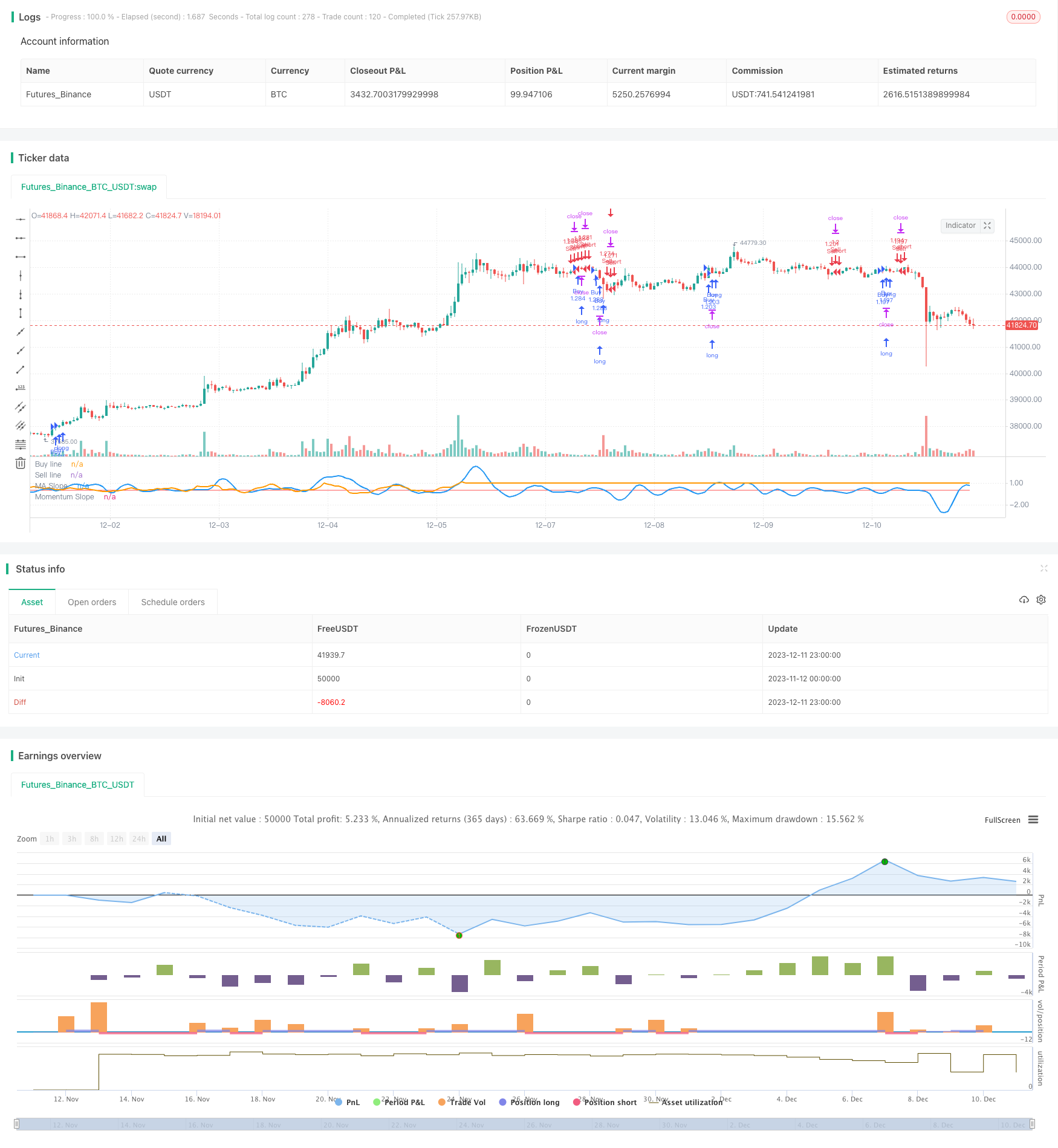
概述
本策略利用移动平均线(MA)的斜率和动量指标的斜率进行交易决策。它会比较 MA 斜率和动量斜率与设定的阈值,当两条斜率都超过阈值时产生交易信号。该策略还包含低波动过滤器,在市场波动性低时使用不同的 MA 生成信号。
策略原理
本策略的核心在于比较两条斜率曲线。首先,它会计算 MA 和动量指标的斜率。斜率反映曲线的变化速度和方向。然后使用两个阈值,当两条斜率曲线都超过相应的阈值时产生交易信号。
例如,当 MA 斜率和动量斜率都超过上轨时,产生买入信号;当两条曲线都跌破下轨时,产生卖出信号。这样可以过滤掉部分假信号。
低波动过滤器使用一个长期 MA 判断市场波动性。当波动性低时,使用不同参数的 MA 生成交易信号,从而适应不同市场状态。
优势分析
本策略具有以下几个优势:
使用双重过滤器设定交易信号,可以过滤掉部分噪音,提高信号质量。
低波动过滤器使得策略可以适应不同的市场状态,具有弹性。
允许高度自定义不同参数,可以针对不同品种进行优化。
含有无复漆功能,可以减少曲线拟合对结果的影响。
风险分析
本策略也存在一些风险:
双重过滤可能过滤掉部分真实信号,导致错过机会。可以通过调整参数优化。
低波动过滤器判定阈值需要仔细测试确定。如果参数不当可能出现信号偏差。
MA 和动量指标参数设置需要针对具体品种优化,全市场通用参数难以确定。
无复漆功能无法完全规避回测曲线拟合问题,实盘效果仍需验证。
高度自定义参数会使参数空间复杂化,优化难度增加。
优化方向
本策略可以从以下几个方向进行优化:
测试更多种类的 MA 和动量指标的组合,找到最匹配的指标。
优化 MA 和动量指标的长度参数,平衡延迟和噪音。
优化斜率计算的参数,找到更稳定指标的组合。
测试不同的低波动性指标和参数,提高弹性。
在不同品种和周期上测试,寻找最佳适用范围。
构建参数自适应机制,减少手动优化工作量。
总结
本策略整体是一个非常灵活和可自定义的双 MA 策略。它同时参考价格和动量信息进行决策,可以有效过滤假信号。低波动过滤器也使得策略更具弹性,能够适应市场的变化。
通过参数优化和指标选择的改进,本策略可以成为一个值得考虑在实盘中应用的选择。它为利用 MA 和动量指标进行交易决策提供了一个参考模板。
/*backtest
start: 2023-11-12 00:00:00
end: 2023-12-12 00:00:00
period: 1h
basePeriod: 15m
exchanges: [{"eid":"Futures_Binance","currency":"BTC_USDT"}]
*/
// This source code is subject to the terms of the Mozilla Public License 2.0 at https://mozilla.org/MPL/2.0/
// © Allenlk
//@version=4
strategy("DRSI DMA Scalping Strategy", shorttitle="DRSIDMA", overlay=false, initial_capital=1000, pyramiding=2, default_qty_type=strategy.percent_of_equity, default_qty_value=100)
//Inputs
matype = input(7, minval=1, maxval=8, title="1=SMA, 2=EMA, 3=WMA, 4=HullMA, 5=VWMA, 6=RMA, 7=TEMA, 8=Tilson T3", group="Moving Average")
masrc = input(close, title="MA Source", group="Moving Average")
malen = input(5, title="Moving Average Length - LookBack Period", group="Moving Average")
factorT3 = input(defval=7, title="Tilson T3 Factor - *.10 - so 7 = .7 etc.", minval=0, group="Moving Average")
maderiv = input(3, title="MA Slope Lookback", minval=1, group="Moving Average")
masmooth = input(5, title="MA Slope Smoothing", minval=1, group="Moving Average")
momtype = input(3, minval=1, maxval=3, title="1=RSI, 2=CCI, 3=RSI/ROC", group="Momentum Moving Average")
momsrc = input(close, title="Momentum Source", group="Momentum Moving Average")
momlen = input(3, title="Momentum Length", minval=1, group="Momentum Moving Average")
momderiv = input(8, title="Momentum Slope Lookback", minval=1, group="Momentum Moving Average")
momsmooth = input(7, title="Momentum Slope Smoothing", minval=1, group="Momentum Moving Average")
higherTf = input("1", title="Higher timeframe?", type = input.resolution, group="Time Resolution")
higherTfmult = input(130, title="MA Slope multiplier for Alternate Resolutions (Make the waves of the blue line similar size as the orange line)", group="Time Resolution")
buffup = input(0.02, title="Buy when both slopes cross this line", step=0.01, group="Buy and Sell Threshold")
bufflow = input(-0.03, title="Sell when both slopes cross this line", step=0.01, group="Buy and Sell Threshold")
lowVolMALength = input(28, title="Big MA Length", minval=1, group="Low Volatility Function")
MAlength = input(10, title="Low Volatility Moving Average Length", minval=1, group="Low Volatility Function")
MAThresh = input(0.05, title="Low Volatility Buy and Sell Threshold", step=0.01, group="Low Volatility Function")
Volminimum = input(2.5, title="Minimum volatility to trade", minval=0, step=0.01, group="Low Volatility Function")
//Low Volatility Function
//When Volatility is low refer to the slope of a long moving average
low_vol_MA = sma(close, lowVolMALength)
low_vol_down = (low_vol_MA[3] - low_vol_MA[1]) > MAThresh
low_vol_up = (low_vol_MA[3] - low_vol_MA[1]) < MAThresh * -1
percent_volatility = (1 - (low / high)) * 100
chng_MA = sma(percent_volatility, MAlength)
bad_vol = chng_MA < Volminimum
//No repaint function
nrp_funct(_symbol, _res, _src) => security(_symbol, _res, _src[barstate.isrealtime ? 1 : 0])
//hull ma definition
hullma = wma(2*wma(masrc, malen/2)-wma(masrc, malen), round(sqrt(malen)))
//TEMA definition
ema1 = ema(masrc, malen)
ema2 = ema(ema1, malen)
ema3 = ema(ema2, malen)
tema = 3 * (ema1 - ema2) + ema3
//Tilson T3
factor = factorT3 *.10
gd(masrc, malen, factor) => ema(masrc, malen) * (1 + factor) - ema(ema(masrc, malen), malen) * factor
t3(masrc, malen, factor) => gd(gd(gd(masrc, malen, factor), malen, factor), malen, factor)
tilT3 = t3(masrc, malen, factor)
//MA Type
avg = matype == 1 ? sma(masrc,malen) : matype == 2 ? ema(masrc,malen) : matype == 3 ? wma(masrc,malen) : matype == 4 ? hullma : matype == 5 ? vwma(masrc, malen) : matype == 6 ? rma(masrc,malen) : matype == 7 ? 3 * (ema1 - ema2) + ema3 : tilT3
//MA Slope Percentage
DeltaAvg = (avg / avg[maderiv]) - 1
SmoothedAvg = sma(DeltaAvg, masmooth)
MAout = nrp_funct(syminfo.tickerid, higherTf, SmoothedAvg) * higherTfmult
//Momentum indicators
Momentum = momtype == 1 ? rsi(momsrc, momlen) : momtype == 2 ? cci(momsrc, momlen) : momtype == 3 ? rsi(roc(momsrc,momlen),momlen) : na
//Momentum Slope Percentage
Deltamom = (Momentum / Momentum[momderiv]) - 1
SmoothedMom = sma(Deltamom, momsmooth)
Momout = nrp_funct(syminfo.tickerid, higherTf, SmoothedMom)
//Plottings
plot(buffup, color=color.green, title="Buy line")
plot(bufflow, color=color.red, title="Sell line")
plot(MAout, color=color.blue, linewidth=2, title="MA Slope")
plot(Momout, color=color.orange, linewidth=2, title="Momentum Slope")
longCondition = bad_vol ? low_vol_up : MAout > buffup and Momout > buffup
if (longCondition)
strategy.entry("Buy", strategy.long)
shortCondition = bad_vol ? low_vol_down : MAout < bufflow and Momout < bufflow
if (shortCondition)
strategy.entry("Sell", strategy.short)